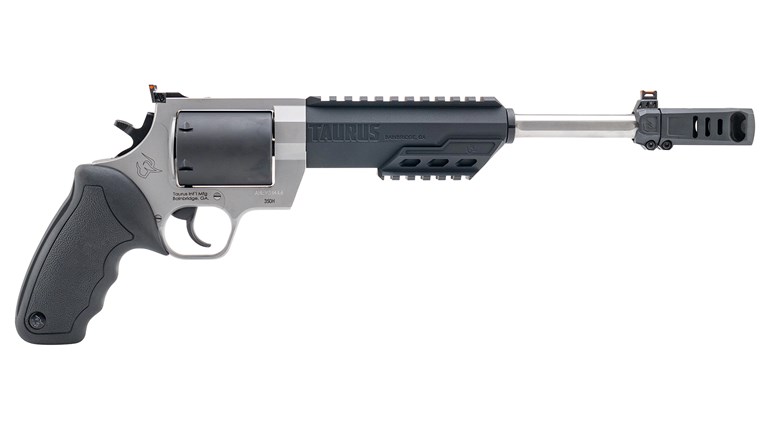** When you buy products through the links on our site, we may earn a commission that supports NRA's mission to protect, preserve and defend the Second Amendment. **

Whether you call it an axe or a hatchet (which is actually a matter of some debate), if you spend much time in the outdoors, you will find this your most useful tool. Besides felling trees and chopping wood for fire and shelter, a well-sharpened axe can, in a pinch, skin and clean game. If necessary, the steel axe-head can even be used with a piece of flint to start a fire. Axes come in different sizes to perform different jobs—small, medium and large—according to the weight of the axe-head and the length of the handle. In general, a camp axe is a small axe with a head weighing about 2 to 2.5 pounds and a handle between 20 and 28 inches long. It will chop small to medium size logs easily and can be used for bigger jobs if the edge is kept razor sharp. The camp axe takes up very little space, and is ideal when horsepacking or camping in small quarters. Here are eight things to know about selecting and caring for your camp axe.
1. No matter what size axe you choose, it should have a forged steel rather than cast steel head. Cast steel does not hold a sharp edge as well, and breaks more readily than forged steel. The best axes are made from high-quality carbon steel which has been tempered to resist brittleness.
2. When selecting a wood-handled axe, be sure the grain of the wood is straight for the entire length of the handle. Hickory is considered the best wood for axe handles.
3. Don't attempt to patch a cracked or splintered axe handle. You must replace it.
4. When replacing a wood axe-handle, cut off the old handle as close to the metal head as possible. The remaining wood can be dug out of the eye (which is the hole where the haft is mounted) of the axe-head in small pieces. Insert the new handle in the eye and tap it into place. Cut two hardwood wedges and insert them in the axe-head next to the handle. Drive the wedges in as far as they will go, so the handle is seated snugly in position and is as tight as possible.
5. To protect the axe handle, rub linseed oil into the wood of the handle along its entire length using a soft cloth. Never varnish or paint an axe-handle. Painted or varnished handles can cause your hands to blister during use.
6. If an awe-head is loose, do not use it until it has been tightened. You can tighten a loose handle by driving the hardwood wedges in further to fit more snugly, or you can soak the axe-head in water...which will cause the wood to swell, and the handle will then fit more tightly.
7. In extremely cold weather, always warm an axe before starting to cut. Cold makes the metal brittle, which could cause the axe-blade to snap.
8. When using an axe, always work on a chopping block. A stump or log is fine for this purpose. Always be sure no one is standing in line with the swing of your axe; ensure that the area of the entire swing is clear of all obstructions.
Editor's note: The axe pictured above is the "Axe Gang Hatchet" from Cold Steel. You can read more about it here!
1. No matter what size axe you choose, it should have a forged steel rather than cast steel head. Cast steel does not hold a sharp edge as well, and breaks more readily than forged steel. The best axes are made from high-quality carbon steel which has been tempered to resist brittleness.
2. When selecting a wood-handled axe, be sure the grain of the wood is straight for the entire length of the handle. Hickory is considered the best wood for axe handles.
3. Don't attempt to patch a cracked or splintered axe handle. You must replace it.
4. When replacing a wood axe-handle, cut off the old handle as close to the metal head as possible. The remaining wood can be dug out of the eye (which is the hole where the haft is mounted) of the axe-head in small pieces. Insert the new handle in the eye and tap it into place. Cut two hardwood wedges and insert them in the axe-head next to the handle. Drive the wedges in as far as they will go, so the handle is seated snugly in position and is as tight as possible.
5. To protect the axe handle, rub linseed oil into the wood of the handle along its entire length using a soft cloth. Never varnish or paint an axe-handle. Painted or varnished handles can cause your hands to blister during use.
6. If an awe-head is loose, do not use it until it has been tightened. You can tighten a loose handle by driving the hardwood wedges in further to fit more snugly, or you can soak the axe-head in water...which will cause the wood to swell, and the handle will then fit more tightly.
7. In extremely cold weather, always warm an axe before starting to cut. Cold makes the metal brittle, which could cause the axe-blade to snap.
8. When using an axe, always work on a chopping block. A stump or log is fine for this purpose. Always be sure no one is standing in line with the swing of your axe; ensure that the area of the entire swing is clear of all obstructions.
Editor's note: The axe pictured above is the "Axe Gang Hatchet" from Cold Steel. You can read more about it here!






































